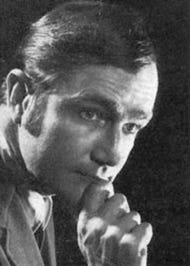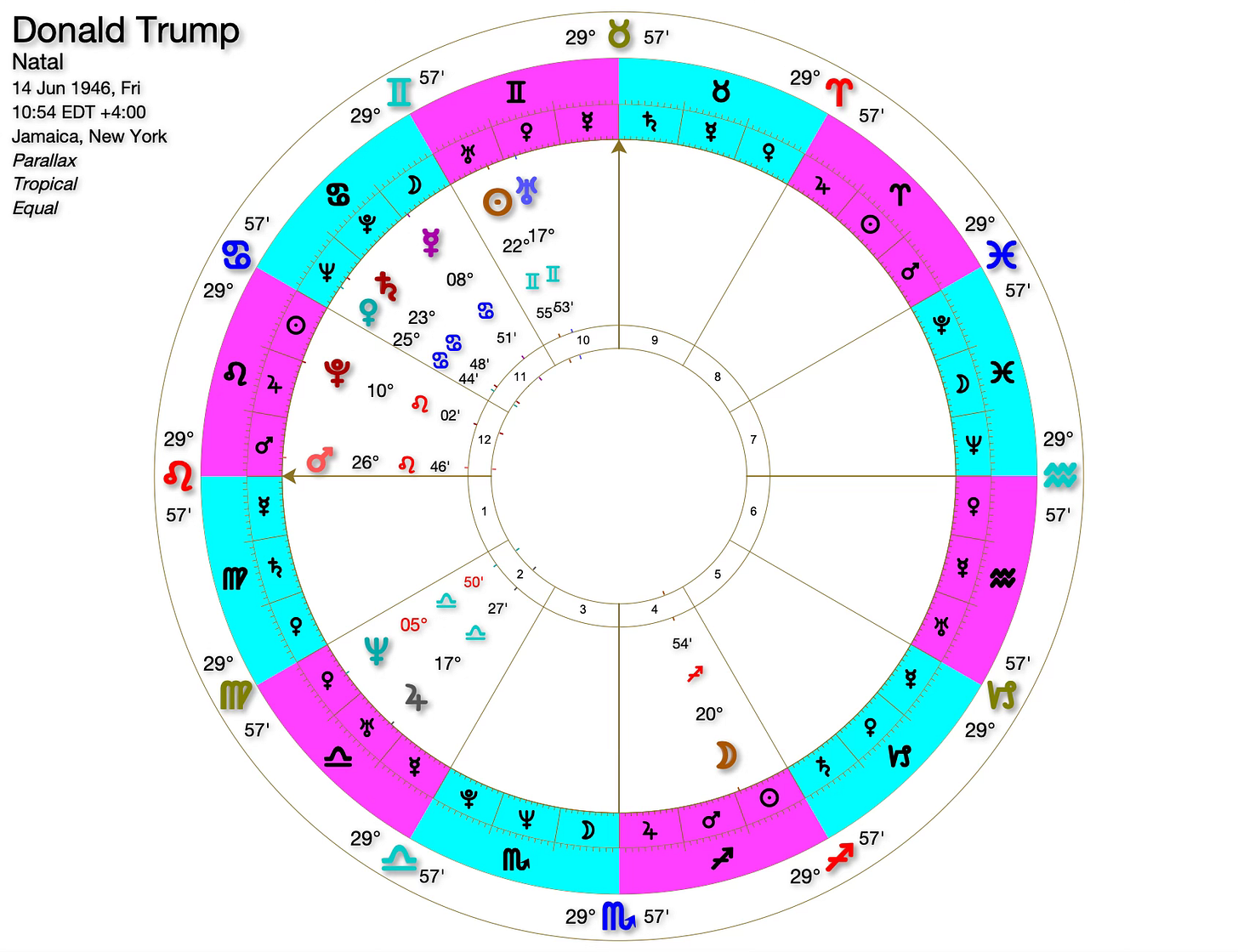Robert Carl Jansky
Several authors have followed Jones’ approach to chart shapes and in some cases have developed them further. Most significantly, Robert Carl Jansky took a fresh look at Jones’ methods and added an eighth shape, which he called the Fan. His book Planetary Patterns provides detailed definitions for each shape, but is unfortunately out of print. Jansky wrote:
“By recognizing the planetary pattern within the horoscope we can recognize the individual’s basic framework for living. Each of the patterns represents a basic mode of psychological expression as well as a basic mode of dealing with the immediate environment, and a characteristic method of dealing with problems.”
Jansky’s Fan is similar to the Bucket, with both shapes having one handle planet outside the main cluster of nine planets. But whereas the cluster in a Bucket chart spreads up to 180°, like a Bowl, the Fan’s cluster covers a much narrower 120°, like a Bundle. Importantly, the handle planets have different functions, the Bucket’s acting as a support to the other nine planets, whereas the Fan’s handle drives the blade which comprises the planets in the Bundle. This will be elaborated on in a future article.
Before his death, Jansky was in discussion with Marion March about a ninth shape that she proposed, called the Wheelbarrow. She and her students subsequently found sufficient research evidence to support its inclusion in the system, and she wrote about it in volume 2 of The Only Way To Learn Astrology. We’ll take a closer look at the Wheelbarrow in due course.
Dane Rudhyar
In researching this introduction to chart shapes I found a relevant chapter in Dane Rudhyar’s Person-Centered Astrology. Originally published as First Steps in the Study of Birth Charts, Rudhyar acknowledges Jones’ A Guide to Horoscope Interpretation as a “very significant work” that is “no doubt valid in terms of the author’s philosophical background”. He adds:
“I feel nevertheless that the entire subject of defining, naming and interpreting these basic types of structural arrangements should be reexamined, and that a new list of classes of patterns has to be made and differently interpreted in accordance with the basic principles of the holistic thinking I am formulating.”
Rudhyar adopted Jones’ over-arching categorisation of chart shapes as Bipolar or Tripolar, but re-named them Dualistic and Triangular Patterns. Apart from the Seesaw, he also re-named all of the shapes as: Hemispheric (Bowl), Funnel (Bucket), Tripod (Splay), Cluster (Bundle), and Open Angle (Locomotive).
Rudhyar did not recognise Jones’ Splash shape, suggesting instead that charts of this type should be defined and evaluated in a different way. Rather than conforming to a harmonic kind of distribution, he said they “present a picture of relative disorder (which) can be a highly creative type of disorder or disharmony”.
He also added a “Fourfold Pattern”, “Star Patterns” (either 5- or 6-pointed), and “Non-Harmonic Patterns”, i.e. “cases that do not fit into even the broadest categories of organization”.
Apart from a chapter in Michael R. Meyers’ classic A Handbook for the Humanistic Astrologer, which outlines Rudhyar’s work on chart shapes, and passing references in Lance Carter’s Planetary Patterns and High Focus Planets, I’m not aware of any astrologers who’ve taken Rudhyar’s ideas on the subject and developed them further.
Ellias Lonsdale
Although Ellias Lonsdale has not published anything on chart shapes, he has created a set of more evocative names for them, and has taught a new approach to understanding the psychological types associated with them.
He has also made an important but virtually unknown contribution to chart shape theory by adding a category that he calls Mutational. Although others have recognised that some horoscopes are asymmetrical and don’t fall easily into any of the standard chart shapes (e.g. Rudhyar with his Non-Harmonic Pattern), Ellias has given a detailed description of the Mutational type. It may be summarised as “The alien maverick torch bearer seeking out and mutating unique and pioneering new pathways”.
My own previous study of chart shapes led me to conclude that some charts seem to be a combination of two, or even three shapes. What’s certain is that the chart shape description(s) that the individual resonates with most is the right one, even if another shape is technically more correct.
Planetary Departments and Dynamic Focus
Frances Sakoian (author of the classic The Astrologer’s Handbook) and Betty Caulfield included two chapters on Jones’ chart shapes in their book Astrological Patterns. After providing a summary of Jones’ seven shapes, they review his ideas on natural disposition and then elaborate on his concept of ‘planetary departments’. Jones wrote about these in Essentials of Astrological Analysis in a chapter titled ‘The Self-Ordering’.
Jones paired Sun and Moon, Jupiter and Saturn, Mars and Venus, and Uranus and Neptune as planetary departments of self-determination. He also coupled Mercury with Mars and Venus, and Pluto with Uranus and Neptune. John Sandbach simplifies Jones’ ideas on departments in his Manual of Astrology.
The authors of Astrological Patterns also simplify Jones’ departments by reducing them from four to two, with Sun, Moon, Jupiter and Saturn being the planets of inner experience, and the remaining six planets representing outer experience. Significance is given to which group the strongest and closest square or opposition in the chart belongs to. This is said to be the ‘dynamic focus’ of the personality. Delineations are provided for each of the planets when they are in either a ‘point focus’ square or opposition.
Case Study
Applying Jones’ basic method to Donald Trump’s horoscope, all planets are located within half the chart. At first glance it appears to have a Bowl shape, with Uranus as leading planet and the Moon as trailing planet. The TimePassages program gives this delineation.
But Jansky states emphatically that “never will there be a space between any two planets that exceeds 60 degrees”. The gap between Trump’s Moon and Jupiter is over 63°. We therefore have to consider the alternatives, and Jansky’s Fan shape fits the bill. The Sirius program confirms this, stating:
“Your chart is a pure Fan type. There is a single planet separated from the other planets by an angular distance of at least 60° on one side and at least 75° on the other side, and the spread of the 9 planets opposed to the handle is less than 125°. You are highly focused and have a clear idea of what you want and where you are headed in life. Your confidence and clarity are likely to help you succeed in life, but you sometimes run the risk of overlooking the needs and interests of others in your passion for what you feel focused on. The Moon is the singleton planet (in the Western hemisphere; MC = 24° Taurus 21’). You bring a depth of feeling and a sense of the heritage and history behind what you are passionate about.”
In effect, the Fan is a Bundle with a handle planet. As mentioned above, “the Fan’s handle drives the blade which comprises the planets in the Bundle.” Trump’s Out Of Bounds Moon is therefore the driving force of the chart. The midpoint of the Bundle (i.e. Jupiter/Uranus) is 17° Leo 40’, with Mars/Pluto = 18° Leo 25’. Interestingly, transiting Mercury was at 17° Leo 21’ when he was shot.
Trump’s horoscope shows why it’s vital to understand the method of calculating chart shapes, and then checking and double checking even when a shape looks clear cut.
This series of articles aims to help readers (as well as the author) develop more expertise in using the chart shapes technique. In the next article I will focus on the easiest of the shapes to recognise, the Bundle (aka Fireball).
Resources
The Guide to Horoscope Interpretation, Marc Edmund Jones.
https://archive.org/details/guidetohoroscope00jonerich/mode/2up and
https://archive.org/details/guidetohoroscope00jone
Essentials of Astrological Analysis, Marc Edmund Jones.
https://archive.org/details/essentialsofastr0000marc
Planetary Patterns, Robert Carl Jansky.
Discover the Aspect Pattern in Your Birth Chart: A Comprehensive Guide, Glenn Mitchell.
Planetary Patterns and High Focus Planets in Spherical Astrology, Lance Carter.
The Only Way To Learn Astrology Volume 2, lesson 10, Marion D. March And Joan McEvers.
https://archive.org/details/onlywaytolearnas0002mari
Aspect Patterns: What They Reveal and How They are Triggered, Stephanie Jean Clement.
https://archive.org/details/aspectpatternswh0000clem/page/n7/mode/2up
The Art of Chart Interpretation, Tracy Marks.
https://archive.org/details/artofchartinterp00mark and
https://archive.org/details/artofchartinterp00trac
Astrological Patterns: The Key to Self-Discovery, Frances Sakoian & Betty Caulfield.
https://archive.org/details/astrologicalpatt00sako
Chart Shapes: The Code to Interpretation, Wanda Sellar.
Manual of Astrology: a summary of guidelines for astrological interpretation, John Sandbach
https://johnsandbach.net/wp-content/uploads/2024/05/Manual_of_Astrology_by_John-_Sandbach.pdf
First Steps in the Study of Birth Charts, included in Person-Centered Astrology, Dane Rudhyar.
http://mindfire.ca/Person Centered Astrology/Chapter Sixteen - Planetary Patterns.htm
Astrology Lessons, Bob Marks
https://bobmarksastrologer.com/intermediate/
A handy guide to Marc Edmund Jones’ chart shapes:








Thank you so much for gliding us through the myriad of lenses one can look at chart shapes. I have a chart shape that even my astrology teacher was unable to pinpoint. When I go for readings, I get a different shape analysis every time. Well, at least from the astrologers that use chart shapes.